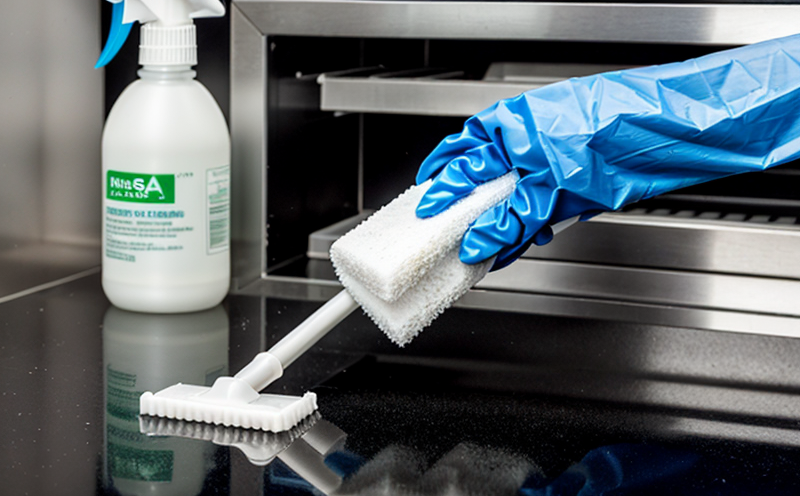DIN EN ISO 846 Plastics Microbial Colonization Testing
The DIN EN ISO 846 standard is a critical guideline in testing the microbial colonization of plastics, particularly those intended for use in hygiene and cleaning applications. This method evaluates the ability of plastic materials to resist contamination by microorganisms, which can have significant implications on product safety and performance.
This test is essential because microbial colonization can lead to degradation of plastic properties over time, reduced service life, and potential health risks if the material comes into contact with food or other hygienic applications. The standard provides a standardized procedure for simulating real-world conditions that plastics may encounter in hygiene environments.
The testing process involves exposing specimens of the plastic to a specific microbial inoculum under controlled environmental conditions. After incubation, the extent and nature of colonization are assessed visually and by quantifying viable microorganisms using appropriate microbiological methods. This includes counting colonies on agar plates or using ATP bioluminescence assays.
The DIN EN ISO 846 standard is particularly relevant for high-touch surfaces in healthcare settings, food processing equipment, and consumer products like cleaning tools and personal hygiene items. Compliance with this standard ensures that plastic materials meet stringent hygiene requirements and contribute to a safer environment.
Testing parameters are meticulously defined within the standard, ensuring reproducibility and comparability of results across different laboratories. This includes specifying the type of microbial inoculum used (such as a mixture of common environmental bacteria), the incubation period, and temperature conditions. Specimen preparation is also detailed, requiring that test samples be cut into standardized dimensions to ensure consistent exposure.
Instrumentation plays a crucial role in this testing process. Automated colony counters and ATP bioluminescence readers are commonly used for rapid and accurate quantification of microbial colonies. These instruments provide precise measurements, reducing the potential for human error and enhancing data reliability.
Reporting results is another critical aspect of DIN EN ISO 846 compliance. Detailed reports include quantitative measures of microbial growth, visual assessments of surface contamination, and comparisons with control samples not exposed to the inoculum. This comprehensive approach ensures that manufacturers have a clear understanding of their product's performance in terms of microbial resistance.
Understanding the implications of microbial colonization is essential for quality managers, compliance officers, R&D engineers, and procurement teams involved in hygiene plastic design and manufacturing processes. By adhering to DIN EN ISO 846 standards, these professionals can ensure that their products meet rigorous hygiene requirements and contribute to a safer environment.
Applied Standards
- DIN EN ISO 846:2015-03 - Plastics -- Determination of microbial colonization on surfaces
The DIN EN ISO 846 standard is widely recognized as the authoritative guide for conducting tests to determine the extent of microbial colonization on plastic surfaces. This international standard ensures that testing methods are consistent and reliable, facilitating accurate comparisons between different materials.
Industry Applications
The DIN EN ISO 846 test is particularly applicable in the healthcare sector where hygiene standards are paramount. Hospitals, surgical equipment manufacturers, and personal care product developers rely on this standard to ensure their products do not become contaminated with harmful microorganisms.
In the food processing industry, compliance with DIN EN ISO 846 helps prevent cross-contamination that could lead to foodborne illnesses. This is especially crucial for packaging materials, utensils, and other equipment in direct contact with food products.
Consumer goods manufacturers also benefit from adhering to this standard, as it enhances the safety and reliability of their products, particularly those used in cleaning applications or in environments where hygiene is a concern. By ensuring that plastics meet DIN EN ISO 846 standards, these companies can build trust with consumers regarding product safety.
Use Cases and Application Examples
| Application | Description | Testing Parameters |
|---|---|---|
| Hospital Room Furniture | Evaluating the microbial resistance of furniture used in patient rooms. | Exposure to 106 cfu/cm² of mixed bacterial inoculum for 24 hours at 37°C. |
| Cleaning Tools | Determining the effectiveness of cleaning tools in maintaining hygienic standards. | Submersion of tools in a solution containing 105 cfu/ml for 30 minutes at room temperature. |
| Toothbrush Holders | Assessing the microbial resistance of toothbrush holders used in dental clinics. | Exposure to 105 cfu/cm² of fungal inoculum for 48 hours at 27°C. |
- Personal Care Products: Testing the microbial resistance of combs, brushes, and other grooming tools used by consumers.
- Cooking Appliances: Ensuring that surfaces in contact with food are resistant to microbial colonization.
- Sanitary Napkin Packaging: Evaluating the hygiene of packaging materials to ensure they do not contribute to bacterial growth.





